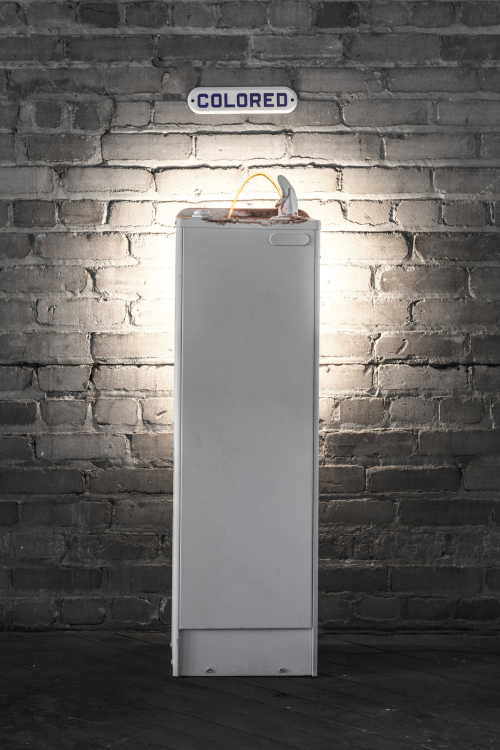The first time I saw this image, everything around me stopped and the hair on my arms stood on end:

Photo courtesy of Ti-Rock Moore
The piece, titled “Flint”, was an entry in the renowned ArtPrize competition in Grand Rapids. It brings the hideous national shame and stain of Jim Crow-era racism and systemic white supremacy and slams it like two beams in a particle collider into the environmental & governmental racism and white supremacy of the Flint Water Crisis. Like most truly great pieces of art, it needs to no explanation.
The piece is by New Orleans artist Ti-Rock Moore, a white woman who uses her art to confront the racism and white supremacy that corrupts and infects our country. I spoke with Moore by phone this week and she told me that she wants to use both her art and her white privilege to expose this country’s shameful history as well as its equally shameful present.
Brown water continuously flows in the water fountain which is marked with the sign “Colored”. The basin of the water fountain is corroded and stained, like the pipes and appliances of the victims in Flint. It wasn’t always like that. When Moore first created the piece, the basin was pristine and white. But, Moore told me, after a year and a half of brown water flowing in it, the staining and corrosion happened organically, transforming the piece with time, much like the corrosive and insidious impacts of racial injustice minority communities experience every day of their lives. You can see what it looked like in the beginning in a must-read interview with the artist at Nylon HERE.
Here’s what the artwork looks like today:
#Flint has been without clean water since April24,2014. #Artprize #Fountainstreetchurch
#FlintWaterCrisis#vote66394 #Artprize9#Artprize2017 pic.twitter.com/XtR51rtB4J— Ti-Rock Moore (@TiRockMoore) September 16, 2017
Moore is quick to acknowledge her position of privilege and works hard to make sure she’s not speaking FOR victims of white supremacy. Rather she pulls back the curtain on it, forcing the viewer to confront it directly. Having watched what has happened in New Orleans in the aftermath of Hurricane Katrina, she has a strong perspective on the plight of Flint. African American neighborhoods in New Orleans are still struggling to come back while more affluent, white neighborhoods have largely been restored.
Similarly, Moore recognizes that if what happened in Flint had happened in a white Michigan community, this problem would have already been resolved. “This would never happen in a majority white, middle-class city,” she told MLive. “This is a textbook contemporary example of white supremacy informing policy and resource allocation and overall priorities in this country.”
Moore’s piece took first prize in the competition in the ArtPrize Juried 3-D category meaning that it was judged by a panel of artists. The award comes with $12,500 in prize money. Moore plans to use it to cover expenses, including traveling to Grand Rapids to be at ArtPrize. In addition, she’s making donations to the Flint Child Health and Development Fund as well as the Flint Boys and Girls Clubs. “I want to make it very clear that I don’t buy into the notion of the ‘white savior'”, she told me. “But, because of the sensitivity of me being a white artist and dealing in whiteness, I do always try to either help the community I’m showing in or the community the piece is about. So I’m really, really pleased the money is going to both of those organizations.
“Flint” has been shown at other venues where it received vigorous acclaim. In fact, it was purchased by an important collector who saw it at the Art Basel show even before the show opened. The collector, Beth Rudin DeWoody, agreed to allow it to be shown at ArtPrize because she, like Moore herself, felt it was important that it be shown in Michigan and this was likely the only opportunity for that to happen. It was displayed at the Fountain Street Church in Grand Rapids which teams with the American Civil Liberties Union of Michigan each year to present a themed exhibit that explores issues of social justice. Titled “Art to Change the World: Inspiring Social Justice“, the exhibit “includes works by 26 artists on topics ranging from the continuing water crisis in Flint to the personal struggles wrought by a changing energy industry.”
You can listen to my entire interview with Ti-Rock Moore on next week’s episode of The Sit and Spin Room with LOLGOP & Eclectablog podcast.



